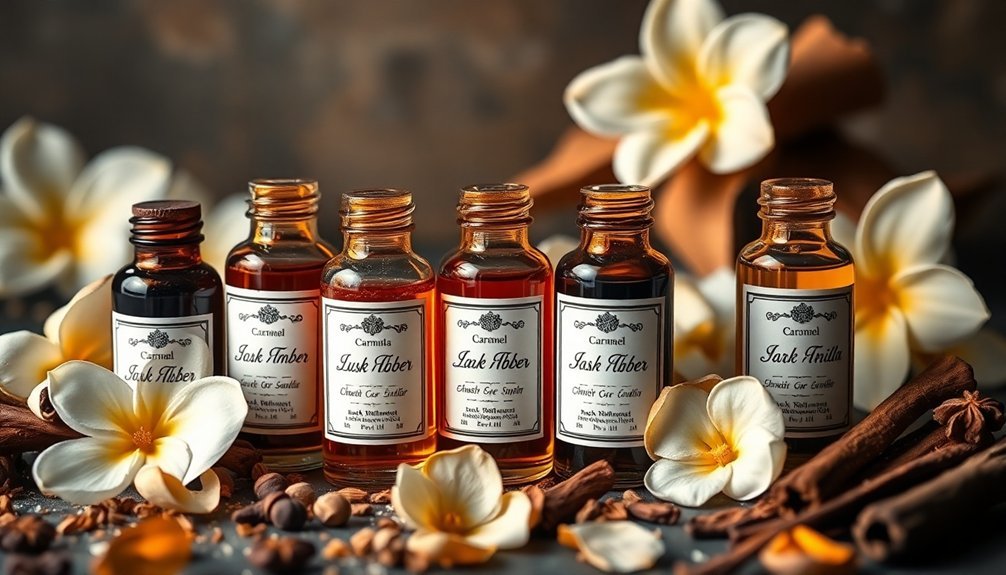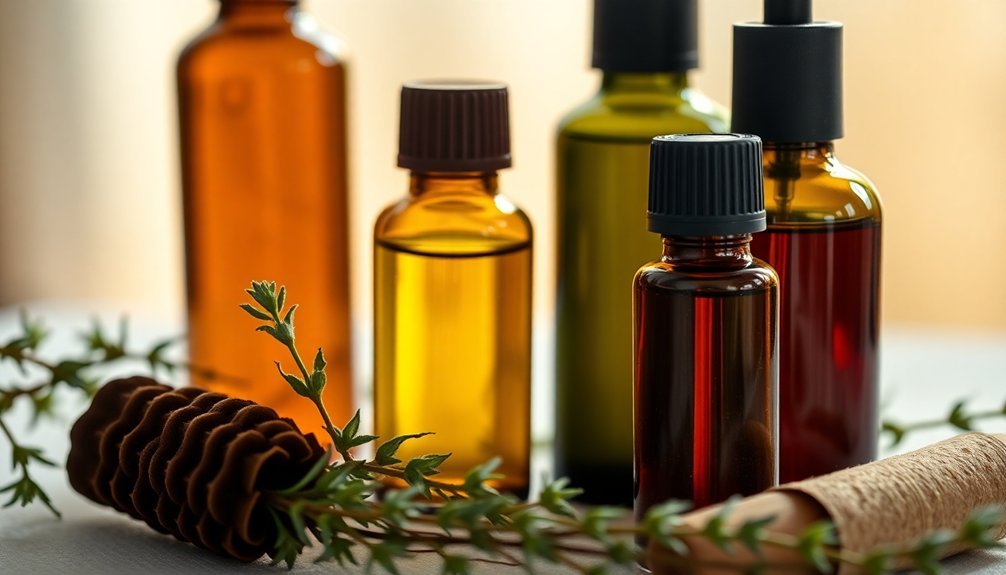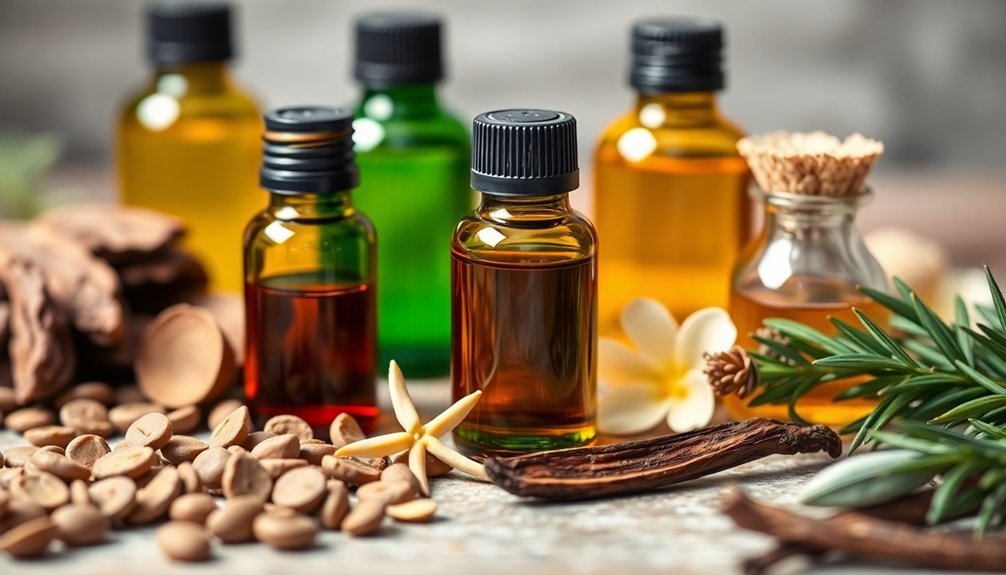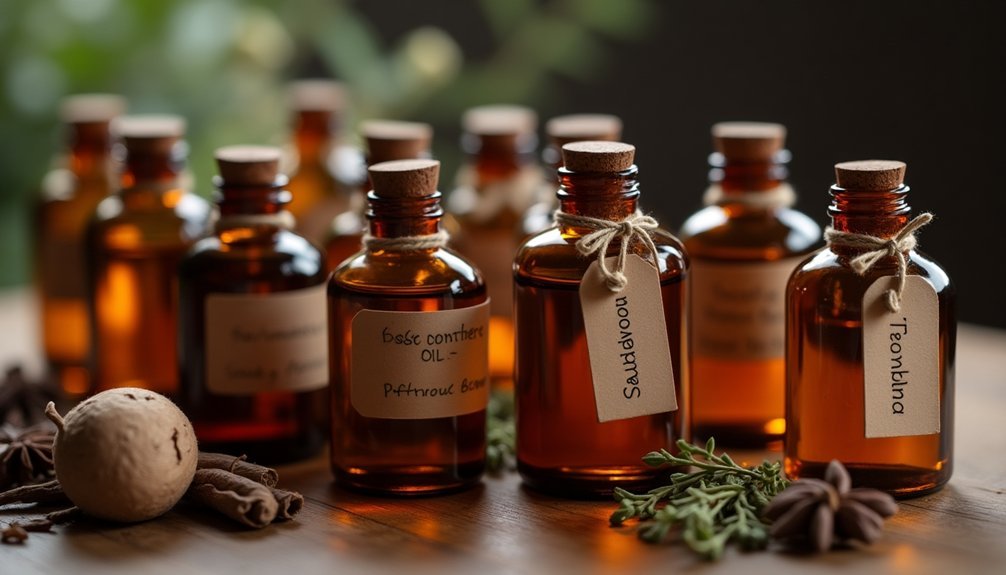For DIY perfumes, you'll get the best longevity by pairing complementary base notes like sandalwood with cedarwood, amber with vanilla, or patchouli with musk. These classic combinations create a deep, lasting foundation that can project for over 24 hours when properly applied to moisturized skin. Start with a 15-20% concentration and apply to pulse points for ideal results. Your signature scent journey opens up endless possibilities with these foundational pairings.
Understanding Base Note Longevity in DIY Perfumes

When creating your own perfume, understanding base note longevity is essential to achieving a lasting fragrance. Base notes like sandalwood, patchouli, and musk have complex chemical structures that allow them to adhere to your skin and evaporate slowly, often lasting over 24 hours.
You'll find that several factors influence how long your base notes last. Your skin type plays a significant role, as does proper application to pulse points and moisturized skin. A dark glass bottle helps maintain the fragrance's potency during storage and maturation.
Store your perfumes in cool, dark places to prevent degradation, and consider using higher concentrations of oils for extended wear. You can enhance longevity by layering scents and incorporating fixatives, which slow down the evaporation rate.
Remember that base notes typically make up 15-20% of your blend, so precise measurements are key to achieving the perfect balance.
Classic Base Note Pairings for Every Fragrance Family
You'll find exceptional staying power with oriental combinations like amber-vanilla and frankincense-myrrh, which create deep, resinous foundations for your DIY perfumes.
For woody-floral bases, try pairing sandalwood with cedarwood or vanilla to achieve a perfect balance between natural earthiness and subtle sweetness. These pairings create lasting scent experiences that can remain detectable on skin for several days.
The most grounding base pairs often come from earthy combinations like patchouli-sandalwood or musk-amber, which provide rich, complex undertones that last throughout the day.
Long-Lasting Oriental Combinations
The art of creating long-lasting Oriental fragrances lies in masterfully combining rich base notes that complement and enhance each other.
You'll find that certain combinations consistently deliver exceptional results, especially when you're crafting DIY perfumes that need to last.
For the most enduring Oriental scents, try these proven base note pairings:
- Amber and vanilla create a warm, sensual foundation that's perfectly balanced when you add a touch of musk.
- Sandalwood and labdanum offer a complex woody-resinous base that works beautifully with additional sweet notes.
- Benzoin and tolu balsam provide a sweet, spicy depth that enhances overall longevity.
These combinations stimulate olfactory receptor signals in the brain, creating lasting scent memories.
Remember to trust your nose while experimenting with these combinations.
You can adjust the ratios to match your preferences, but always guarantee you're maintaining balance between the sweet and woody elements.
Woody-Floral Base Foundations
Building on the richness of Oriental combinations, woody-floral foundations offer a timeless approach to crafting sophisticated fragrances.
You'll find classic pairings like sandalwood with jasmine or cedar with rose create depth while maintaining elegance. These combinations work exceptionally well for year-round wear.
When crafting your DIY perfume, start with a woody base note like cedarwood or sandalwood, then layer your chosen floral heart notes.
You can enhance the blend's complexity by adding subtle vanilla undertones or soft musk accents. For summer formulations, keep the woody notes lighter and incorporate citrus top notes.
In winter, you'll want to amp up the base notes' intensity with richer woods like oud or deep patchouli.
Remember to test your creation on your skin, as individual chemistry greatly affects the final scent.
Earthy Perfume Base Pairs
When crafting earthy perfumes, mastering the right base note combinations forms the foundation of a long-lasting, grounded scent.
You'll find that earth-yielded resins like amber and myrrh pair beautifully with woods like sandalwood and oud to create deep, rich bases.
Root-based combinations offer versatility in your perfume creation.
For the most effective earthy foundations, consider these essential pairings:
- Patchouli and vanilla for a sweet earthiness that adds warmth
- Vetiver and cedar to achieve a fresh, grounded character
- Myrrh and amber to fix your fragrance while providing depth
Don't overlook the power of spices and musks in your earthy blends.
Clove with patchouli or cardamom with vetiver can transform your creation into a sophisticated, aromatic experience that'll last throughout the day.
Earthy and Woody Base Note Combinations
Creating enchanting DIY perfumes starts with understanding powerful base note combinations in both earthy and woody families. You'll find that pairing vetiver with oakmoss creates a forest-like atmosphere, while combining patchouli with moss delivers an authentically raw experience. For woody combinations, try cedarwood with sandalwood for a balanced sophistication, or experiment with cedarwood and oud for an exotic touch.
| Base Pair | Character | Best For |
|---|---|---|
| Vetiver & Patchouli | Deep, smoky | Long-lasting scents |
| Frankincense & Myrrh | Resinous, sweet | Complex blends |
| Sandalwood & Amber | Warm, creamy | Comforting fragrances |
When you're crafting your signature scent, don't hesitate to mix these earthy and woody notes. They'll provide your perfume with depth, staying power, and a natural essence that synthetic fragrances can't match.
Sweet and Oriental Base Note Duos

The rich world of sweet and oriental base notes opens up exciting possibilities for DIY perfumers.
If you're looking to create depth and complexity in your fragrances, consider pairing vanilla with tonka bean for a comforting sweetness, or combine benzoin with myrrh for an intense balsamic experience.
These combinations offer excellent sillage and longevity in your perfume creations.
For successful oriental perfume making, focus on these proven base note duos:
- Vanilla + Tonka Bean: Creates a rich, sweet foundation perfect for gourmand scents
- Myrrh + Benzoin: Delivers an intense balsamic accord with licorice undertones
- Opoponax + Frankincense: Provides a velvety, earthy base with sophisticated woody notes
Remember to balance your sweet notes with balsamic elements to achieve harmony in your final composition.
Floral-Supporting Base Note Pairs
Moving beyond oriental bases, floral fragrances require carefully selected base notes to enhance their natural beauty.
For rose perfumes, you'll find musk and cedarwood create depth while sandalwood and oud add sophisticated warmth.
When working with jasmine, try black currant or raspberry for a fruity dimension, or pair it with clove for an elegant spicy touch.
To balance Lily of the Valley's sweetness, incorporate mint or basil for a fresh, herbaceous quality.
Green notes and lemon work particularly well to amplify its dewy character.
For ylang-ylang compositions, sandalwood and patchouli provide earthy depth, while vanilla offers a creamy foundation.
You can also enhance ylang-ylang's sophistication by combining it with jasmine and bergamot for a multi-layered floral experience.
Base Notes That Enhance Fragrance Projection

When you're aiming for maximum projection in your DIY perfume, you'll want to pair complementary base notes that work together to amplify their reach.
Try combining sandalwood with Iso E Super or patchouli with ambroxane to create fragrances that extend beyond your personal space.
For the strongest projection, match amber with irones or vanilla with hedione, as these combinations create an expansive scent cloud while maintaining the longevity typical of base notes.
Strong Scent Combinations
Creating powerful fragrance projections requires strategic pairing of highly diffusive base notes.
You'll want to combine materials that are instantly noticeable when opening the bottle with complementary notes that guarantee lasting impact.
- Sandalwood paired with vanilla creates a rich, warm foundation that projects well while maintaining a sophisticated profile.
- Patchouli combined with jojoba wax delivers extended longevity and improved projection without overwhelming the blend.
- Eucalyptus matched with crisp middle notes guarantees your fragrance maintains its presence long after application.
For best results, keep your base note combinations at 5-10% of the total blend while maintaining 50-75% middle notes.
If you're finding weak projection, try increasing your perfume concentrate to 25%.
This balance helps achieve both impressive projection and lasting power without compromising the fragrance's character.
Long-Range Base Notes
The science of long-range base notes builds directly on strong scent combinations, focusing specifically on materials that maximize both reach and staying power.
You'll want to pair diffusive materials like hedion and broxan with traditional base notes such as sandalwood and patchouli for ideal projection.
To create a long-reaching fragrance, combine sandalwood-type molecules like ebenol and javanol with musk or oud. These pairings enhance both longevity and projection.
Add alpha and beta iron molecules to boost the diffusive properties while maintaining the scent's integrity.
Don't overload your blend with heavy base notes, as this can actually reduce projection.
Instead, maintain a balanced composition with approximately 25% perfume concentrate, ensuring your middle notes have enough presence to carry the scent after the initial evaporation phase.
Extended Wear Pairings
Successful fragrance projection depends heavily on pairing the right base notes with complementary scent molecules.
When combining base notes for extended wear, you'll want to focus on balanced pairings that work together without overwhelming each other.
For maximum projection and longevity, consider these proven base note combinations:
- Sandalwood or cedarwood with musk creates a rich foundation that maintains steady projection while avoiding the heaviness that can weigh down your fragrance.
- Amber paired with vanilla adds depth and sustains the scent while allowing middle notes to carry projection effectively.
- Oriental base notes combined with chypre elements deliver remarkable hold and projection through their complex interactions.
Remember to maintain a balanced concentration of around 25% and use middle notes as bridges to guarantee continuous projection throughout your fragrance's wear time.
Creating Signature Scents With Base Note Layering

When developing your signature scent, mastering base note layering serves as the foundation for a lasting and harmonious fragrance. Start by selecting a grounding base note like vanilla, sandalwood, or musk that mirrors your desired fragrance family. Apply this generously to guarantee longevity.
To create your unique blend, layer complementary scents from the same fragrance family directly onto your clean skin. You'll want to test small amounts first, then adjust the proportions until you achieve the perfect balance.
Remember to give your fragrances time to settle and mix naturally. If you're using multiple scents, apply the strongest one first, then layer lighter notes on top.
Don't forget to evaluate how the notes interact and reapply throughout the day to maintain your signature scent's presence.
Seasonal Base Note Combinations
Choosing ideal base note combinations for each season helps create fragrances that complement the surrounding environment and climate.
You'll want light, floral notes in spring, while summer calls for citrus and aquatic combinations. Fall and winter fragrances benefit from warmer, deeper base notes.
For the perfect seasonal scent, consider these key combinations:
- Spring/Summer – Mix jasmine with sea salt and bergamot for a fresh, airy blend, or combine light musk with tropical fruits for a sunny vibe.
- Fall – Layer sandalwood with vanilla and spicy elements like cinnamon or clove for a cozy autumn fragrance.
- Winter – Blend amber and resins with leather notes, or combine rich woods with spicy depth for warmth during cold months.
These seasonal pairings will guarantee your DIY perfumes match the mood of each time of year.
Balancing Base Notes With Other Fragrance Elements

Creating balanced perfumes requires careful attention to how base notes interact with other fragrance elements in your composition.
You'll want to take into account that base notes typically make up 5-10% of your blend while providing the longest-lasting foundation of your scent.
When working with top notes, remember they'll evaporate within 5-15 minutes, so you'll need to guarantee they complement your chosen base notes despite their brief appearance.
For middle notes, which form 50-75% of your blend, focus on creating a smooth shift between the fleeting top notes and enduring base notes.
You can test your blend's balance using paper strips or skin tests, adjusting as needed.
Think about adding fixatives like myrrh or incorporating jojoba wax to enhance the longevity of your fragrance composition.
Frequently Asked Questions
Can Base Notes Be Used Alone Without Middle and Top Notes?
Yes, you can use base notes alone, but you'll miss the balanced evolution of a complete fragrance. While it's possible, you'll likely experience a heavier, more intense scent without top and middle notes.
How Many Different Base Note Pairs Should Be Combined in One Perfume?
You'll want to limit yourself to 2-3 base note pairs in one perfume. Using too many pairs can overwhelm the fragrance, while combining just a few creates a balanced, harmonious scent profile.
Do Natural and Synthetic Base Notes Blend Well Together?
Yes, you'll find natural and synthetic base notes blend exceptionally well together. They complement each other's strengths – synthetics enhance longevity and stability, while naturals provide depth and richness to your perfume blend.
Are Some Base Note Combinations Better Suited for Specific Skin Types?
Yes, your skin type greatly influences which base notes work best. You'll find richer bases suit dry skin, lighter ones work for oily skin, and you'll need balanced combinations for combination skin.
What Percentage of Base Notes Should Be Used in a DIY Perfume?
You'll want to start with 25% base notes in your DIY perfume, but you can adjust between 5-40% depending on your desired fragrance type. Light summer scents need less, while winter fragrances need more.
In Summary
You've now got the essential knowledge to create lasting DIY perfumes with perfectly paired base notes. Remember to experiment with different combinations, trust your nose, and don't be afraid to break traditional rules. Whether you're crafting a warm oriental blend or a fresh woody scent, your base note choices will define your fragrance's character. Start with these proven pairs, then branch out to develop your signature scent.
References
- https://twinkleapothecary.com/blogs/news/the-best-single-note-perfumes-to-layer-with-your-favorite-scent
- https://www.edensgarden.com/blogs/news/the-art-of-perfume-making-understanding-top-middle-and-base-notes
- https://livesimply.me/diy-homemade-perfume/
- https://www.dnu.dp.ua/docs/ndc/2024/materiali_konferenc/13.pdf
- https://wellnessmama.com/beauty/diy-perfume/
- https://yourperfumeshop.co.uk/blogs/perfume/the-science-behind-fragrance-longevity-how-to-make-your-perfume-last-longer
- https://experience.themerchantofvenice.com/en/2025/01/01/the-longevity-of-a-fragrance/
- https://makesy.com/blogs/news/the-art-of-making-perfume
- https://phlur.com/blogs/perfumery-dictionary/fragrance-longevity-101
- https://thealphamen.com/blogs/geuren/fragrance-notes-and-scent-families





Leave a Reply